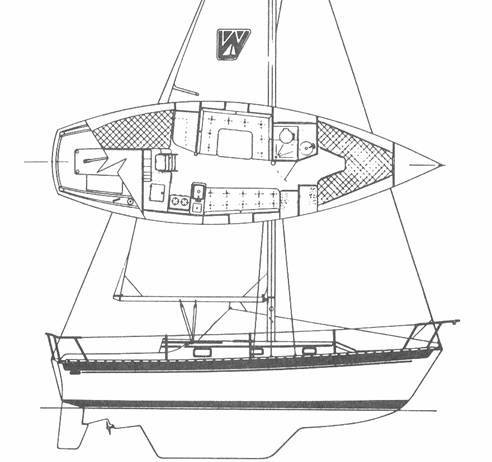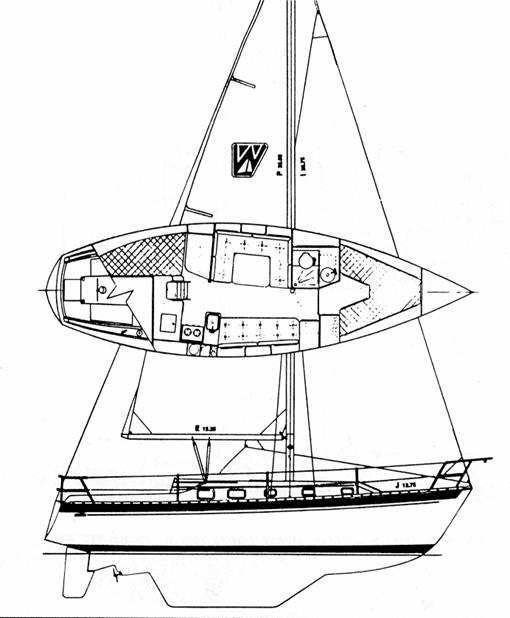|
W A T K I N S W 3 2 / W 3 3 |
|
D E S I G N & H I S T O R Y The W32 was first introduced in 1979. Less than ten of these boats were made. In 1984 the rear transom was slightly changed from nearly vertical to a reverse style and the model designator changed to W33. Also the interior was revamped with storage added in the main salon above the seat back cushions and more surfaces were faced with wood veneer paneling. The changes made the boat look more Watkins like and sales picked up. The W33 model continued in production until the factory closed. The last known W33 built was molded in April of 1988 as an 1989 model. At least 47 total of the two versions (W32/W33) were built.
The boat is sloop rigged with a 4 draft and a skeg mounted rudder. Standard items includes diesel engine, pressure water, shower, six opening ports on the W32 and ten on the W33, and shore power. The galley is aft and to starboard with a sink, 2 burner stove, icebox and storage. There is a hanging locker opposite of the head forward. Teak and holly sole and teak veneer plywood bulkheads and solid teak accents. Headroom is 65 and her mast height above DWL is 43. |

|
SPECIFICATIONS LOA . ..326 LWL . . ...267 Beam . ..102 Draft . .. .40 Disp. ..10,800 lbs. Ballast .5,500 lbs. Sail Area .470 sq. ft. Fuel ...30 gal. Water .40 gal. Mast Height - Above DWL . ......43 Designer ..Watkins |

|
SPECIFICATIONS LOA . ..331 LWL . . ...267 Beam . ..102 Draft . .. .40 Disp. ..11,200 lbs. Ballast .5,500 lbs. Sail Area .470 sq. ft. Fuel ...30 gal. Water .60 gal. Mast Height - Above DWL . ......43 Designer ..Watkins |
H U L L & D E C KThe hull is molded as a single unit of a combination of polyester resin and fiberglass woven roving and multidirectional chopped strand fiber (MCSF). The keel is molded integrally with the hull and all ballast is contained inside. The deck and cockpit, like the hull, are molded as a single unit of a combination of polyester resin and fiberglass woven roving and MCSF. Plywood coring is incorporated between layers of fiberglass in the cabin top, deck, seat, and cockpit sole areas to give additional stiffness. The non-skid finish is molded into the deck. The exterior finish is pigmented gelcoat molded onto the fiberglass. The boot and sheer stripe are also gelcoat molded permanently into the hull. R U D D E R & S T E E R I N GThe rudder is made by Foss Foam, molded as two fiberglass halves, the hollow stainless steal rudder post welded to blades is placed inside and the assembly is filled with a high density foam. The rudder is mounted to a partial skeg for strength. S P A R S & R I G G I N GAll spars (mast, boom, and spreaders) are extruded aluminum 6061-T6 alloy, with a protective coating an all external surfaces. The masts has a single spreader, and booms with single reefing. The W33 has a mast and boom made by Isomat. I N T E R I O RThe interior is a molded fiberglass unit with bulkheads and cabinetry fastened to it with screws, bolts, and adhesives. The interior molded assembly is bonded to the hull with woven roving and mat, that when completed, forms a single unit structure having great strength and rigidity. A U X I L A R YYanmar diesel engines were standard equipment. The 3GMD engines were used on early models and later the 3GM30 was used. The propeller shaft is made of 1" stainless steel and exits the hull through a stuffing box. It is supported at the inboard, or engine end, by the shaft coupling, and at the aft end by a cutless bearing in a shaft log that is a continuation of the keel. In Yanmar engines, the water pump draws water through the engine intake port, circulates it through the engine block, and then into the muffler. The water is mixed with the exhaust gases in the muffler and discharged overboard through the exhaust port. E L E C T R I C A L . .S Y S T E MThe standard battery configuration consisted of two 12-volt batteries connected in parallel to allow single or combined use and charged from the stock 35 amp Hitachi alternator. Last updated 10-20-2006
|